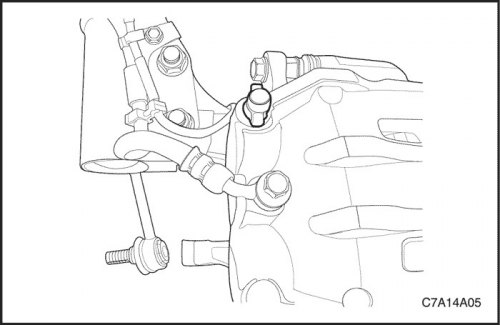Important: Manual bleeding of the hydraulic modulator is not possible. If there is air in the anti-lock brake system hydraulic modulator or if an unfilled modulator is installed, use a diagnostic tool to bleed the brake system. Spare modulators are supplied filled and bled. Air will not enter the modulator when performing standard vehicle maintenance procedures that involve the modulator, such as replacing the brake controller. In such cases, bleed according to the instructions in this section.
1. With the engine off, press the brake pedal several times to equalize the pressure in the vacuum booster with atmospheric pressure.
Important: If there is a suspicion that there is no air in the master cylinder, then bleeding should be started from step 11. If it is suspected that there may be air in the master cylinder, then the master cylinder should be bled starting from step 2.

Note: Do not allow brake fluid to come into contact with the paintwork, as this may damage it.
2. Fill the master cylinder reservoir with brake fluid. During pumping, the reservoir of the master cylinder must be filled with liquid at least half

3. Disconnect the brake line from the master cylinder.
4. Fill the master cylinder with liquid until it begins to pour out through the fitting.
5. Reattach the brake line to the master cylinder.

6. Slowly depress the brake pedal and hold it in this position.

7. With the brake pedal depressed, loosen the brake pipe at the top of the master cylinder to bleed air from the cylinder.
8. Lightly tighten the brake pipe fitting. Then slowly release the brake pedal. Wait 15 seconds before moving on to the next step.
9. Repeat steps 6-8 as many times as necessary to completely remove air from the master cylinder cavity.
10. Tighten the brake pipe.
Tighten
Tighten brake pipe mounting to 16 Nm (12 lb-ft).

11. Install the clear tube onto the bleeder port at the right rear caliper. Dip the end of the tube into the brake fluid poured into a transparent container. After purging the right rear caliper in the sequence described below, it is necessary to perform this procedure using the left front, left rear and right front caliper bleeders.

12. Slowly depress the brake pedal and hold it in this position. When pumping, do not press the brake pedal sharply.
13. While holding the brake pedal down, loosen the bleeder screw to bleed air from the caliper.
14. When the release of air bubbles into the vessel stops, slightly tighten the bleeder screw.
15. Slowly release the brake pedal. Wait 15 seconds before moving on to the next step.
Note: Do not allow brake fluid to come into contact with the paintwork, as this may damage it.
16. Repeat steps 12-15 as many times as necessary to remove all air. The air will be removed completely when the air bubbles stop escaping into the vessel after loosening the bleed screw. During pumping, the reservoir of the master cylinder must be filled with liquid at least half
17. Tighten the bleed screw.
Tighten
Tighten the bleeder screw to 6 Nm (53 lb-in).
18. Perform air bleeding through the remaining calipers in the following sequence: left front, left rear, right front. Use the procedure consisting of steps 11-16.
19. After removing air from all calipers, check the brake pedal for "softness". If the brake pedal is not "hard", then repeat the entire bleeding procedure to eliminate this malfunction.
